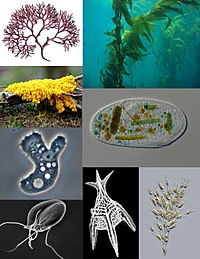
Photo from wikipedia
Abstract Temperature is a key abiotic factor controlling population dynamics. In facultatively sexual animals inhabiting the temperate zone, temperature can regulate the switch between asexual and sexual modes of reproduction,… Click to show full abstract
Abstract Temperature is a key abiotic factor controlling population dynamics. In facultatively sexual animals inhabiting the temperate zone, temperature can regulate the switch between asexual and sexual modes of reproduction, initiates growth or dormancy, and acts together with photoperiod to mediate seasonal physiological transitions. Increasing temperature due to recent global warming is likely to disrupt population dynamics of facultatively sexual animals because of the strong temperature dependence of multiple fitness components. However, the fitness consequences of warming in these animals are still poorly understood. This is unfortunate since facultatively sexual animals—through their ability for asexual reproduction resulting in quick population growth and sexual reproduction enabling long‐term persistence—are key components of freshwater ecosystems. Here, I studied the fitness effects of warming in Hydra oligactis, a freshwater cnidarian that reproduces asexually throughout most of the year but switches to sexual reproduction under decreasing temperatures. I exposed hydra polyps to a simulated short summer heatwave or long‐term elevated winter temperature. Since sexual development in this species is dependent on low temperature, I predicted reduced sexual investment (gonad production) and elevated asexual fitness (budding) in polyps exposed to higher temperatures. The results show a complex effect of warming on sexual fitness: While gonad number decreased in response to warming, both male and female polyps exposed to high winter temperature were capable of multiple rounds of gamete production. Asexual reproduction and survival rate, on the contrary, clearly increased in response to higher temperature, especially in males. These results predict increased population growth of H. oligactis in temperate freshwater habitats, which will likely affect the population dynamics of its main prey (freshwater zooplankton), and through that, the whole aquatic ecosystem.
Journal Title: Ecology and Evolution
Year Published: 2023
Link to full text (if available)
Share on Social Media: Sign Up to like & get
recommendations!